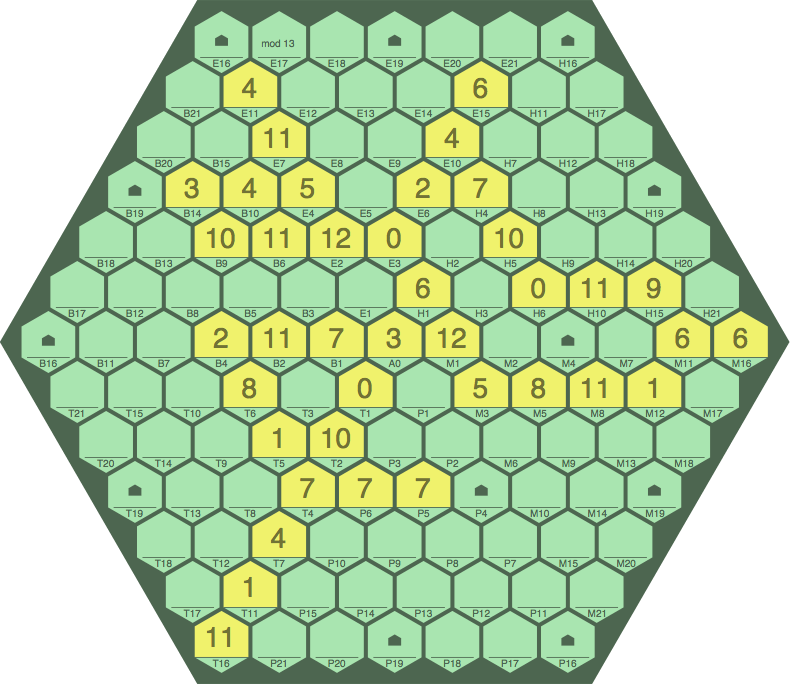
Page 2 (§4-5-6) — examples
Page 3 (§7-8-9) — miscellaneous variations
Page 4 (§10) — fibonacciësque variation
Page 5 (§11) — multiplicative variation
Page 6 (§12-13-14) — wrap-around variation
Page 7 (§15) — comments
§1-1. MODLINSEQ is a numerical tile-based board game for two or more players.
Players install number-bearing tiles on the board to form sequences, with longer sequences earning substantially greater points. Sequences frequently intersect one another obliquely, ultimately forming a large network of tiles. At the end of the game, the player with the highest score wins.
The name is short for MOD-ular LIN-ear SEQ-uence, which will be explained in §2-4 below.
With a green board and yellow tiles, here is what a game in progress could look like:
| figure 1A | ||

| ||
Although much detail is provided below, the gist is this: Wherever there is an unbroken straight line of tiles on the board, their numbers must form an arithmetic progression in modular arithmetic — this is called the modular-linear rule. In this example, the modulus is thirteen. Players take turns, installing tiles which extend old sequences, or which create new sequences that intersect old ones.
Many of the images on this page contain an indication of the modulus (as cell E17 in figure 1A) for guidance in case the image is reproduced out of context, which frequently happens on the internet. The modulus number is not actually printed on the board, as it can change from one game to the next as the players desire.
§1-2. The board can be produced in a variety of shapes and sizes. Here is an example without tiles, as at the beginning of a game:
| figure 1B | ||
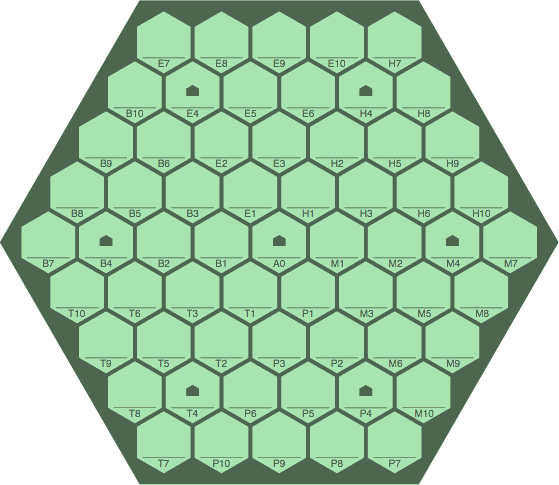
| ||
Although this board has fewer cells than most players would prefer, it still embodies the key properties of a MODLINSEQ board. Essential is that the board be a grid of regular hexagons. Not essential but helpful are the following additional characteristics:
No cell has any distinctive attributes pertaining to how it may be used or how it affects scoring, unless players devise custom rules for particular cells.
Cell addressing starts at the center with cell A0. Cells in the northwest sextant are lettered B, north sextant E, northeast H, southeast M, south P, southwest T. These letters were selected because their glyphs appear in not only the Latin alphabet, but also the Greek and Cyrillic (although pronunciations can differ). This feature facilitates international play.
| table 1A | |||||||||
|---|---|---|---|---|---|---|---|---|---|
| glyphs chosen | others | ||||||||
| Latin | A | B | E | H | M | P | T | K | X |
| Greek | alpha | beta | epsilon | eta | mu | pi | tau | kappa | chi |
| Cyrillic | a | ve | ye | en | em | er | te | ka | kha |
|
Letters O and I are omitted because they can be confused with numerals 0 and 1.
Lower-case letters would differ. | |||||||||
Within each sextant, cells are numbered from the center outward. This center-outward addressing scheme offers the best chance of success to the student who has a board of one size and shape, but who has the transcript of a game played on a board of some other size and shape, and who wants to re-enact that game.
While the typical board will have an overall shape of a regular hexagon, such is not absolutely required, as demonstrated by the board in figure 1C that has been truncated (from this) into a shape that is as nearly rectangular as possible. When truncation is performed, cells are simply dropped without adjusting the addresses of those which remain; the usual effect is that some addresses will be skipped over in the final product. The aim is to preserve addressing consistency among boards that are not alike. As a case in point, if each of two different boards has cells addressed as B26 and B20, then B26 will assuredly be to the immediate left of B20 on both boards.
| figure 1C |
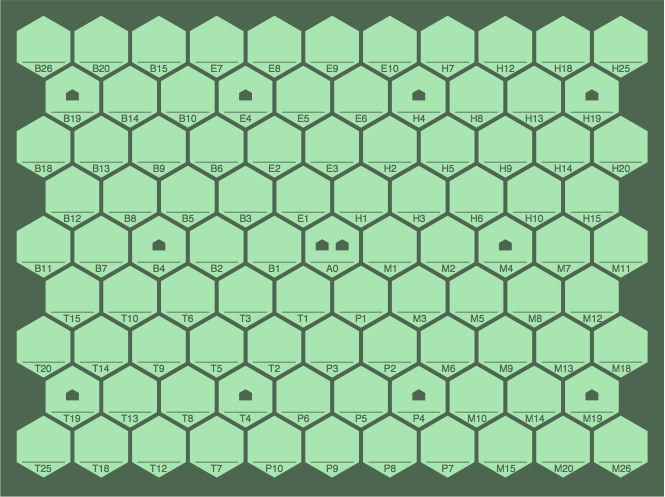
|
The order of an overall-hexagonal board is the number of cells to the left of A0. An excerpt of figure 1B illustrates how this is to be counted:
| figure 1D order 4 |
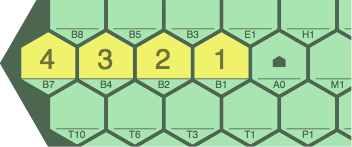
|
Table 1B contains links to images of some boards that have the overall shape of a regular hexagon. Orders 7, 8, and 9 will probably be the most popular. The images are rendered in black and white for the convenience of anyone who wants to customize them.
| table 1B
images are in the portable document format | ||||||||||
| order | cells | image | order | cells | image | order | cells | image | ||
|---|---|---|---|---|---|---|---|---|---|---|
| 0 | 1 | link | 7 | 169 | link | 13 | 547 | link | ||
| 1 | 7 | link | 8 | 217 | link | 14 | 631 | link | ||
| 2 | 19 | link | 9 | 271 | link | 15 | 721 | link | ||
| 3 | 37 | link | 10 | 331 | link | 16 | 817 | link | ||
| 4 | 61 | link | 11 | 397 | link | 17 | 919 | link | ||
| 5 | 91 | link | 12 | 469 | link | 18 | 1027 | link | ||
| 6 | 127 | link | n | 3 × n × (n + 1) + 1 | ||||||
Whatever its shape, the board will probably be printed on some sort of heavy paper or cardboard. One color of ink is sufficient.
§1-3. A tile, which is of a pentagonal shape, bears a small nonnegative integer on its front, for instance:
| figure 1E |

|
The back of each tile is plain, giving no indication of what number is on its front. Each player has a supply of tiles (their hand) whose numbers are not revealed to opponents until the tiles are placed face up on the board in the player's turn.
The tiles might be manufactured thick enough that they stand on edge, like dominoes; or they might be thinner, requiring a rack to hold them. A practical width for a tile is 25 millimeters or 1 inch. Because these tiles do not have rotational symmetry, there is little risk that a player will install a tile on the board in the wrong orientation, mistaking a 6 for a 9.
Before the game, players agree on a modulus, which is a positive integer typically between 8 and 20. The game will then use only those tiles whose numbers are less than the modulus. For example, with a modulus of 15, tiles employed will carry the values 0 through 14. For best results, there should be equal quantities of all the numbers in use.
A feasible set of equipment would furnish ten tiles in each number from 0 to 12. This would allow play with 130 tiles with a modulus of 13; or 120 tiles with a modulus of 12, ten tiles being omitted. Although the rules are the same, game play differs somewhat according to whether the modulus is a prime number (as 13) or not (as 12). A board of order 9 is a good size with this many tiles.
Tiles will likely be manufactured from plastic, although cardboard would suffice as a less durable option.
§2-1. Figure 2A is an excerpt of what the board might look like after the first player's first turn in a game with a modulus of 7. Four tiles have been installed.
| figure 2A transcript: 4B2, 6B1, 1A0, 3M1 |
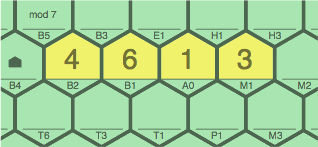
|
This serves as an introduction to what a modular linear sequence is. Writing the tilde to separate terms within a sequence, there are four equally valid ways of calculating the sequence 4 ~ 6 ~ 1 ~ 3:
Indeed, we say that 4 ~ 6 ~ 1 ~ 3 and 3 ~ 1 ~ 6 ~ 4 are merely two different notations for the same sequence. Not surprising is that figure 2B is also a correct installation:
| figure 2B transcript: 3B2, 1B1, 6A0, 4M1 |
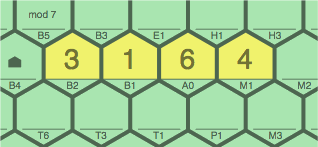
|
Above, figures 2A and 2B show the sequence placed horizontally (zero slope). It can also be installed as below, in figures 2C and 2D (positive slope); or 2E and 2F (negative slope):
| figure 2C transcript: 4T2, 6T1, 1A0, 3H1 | figure 2D transcript: 3T2, 1T1, 6A0, 4H1 | |
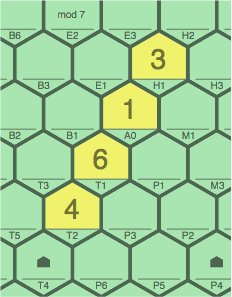
| 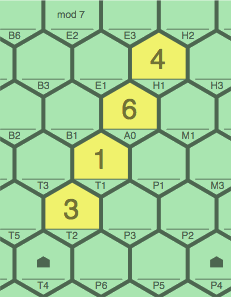
| |
| figure 2E transcript: 4P1, 6A0, 1E1, 3E2 | figure 2F transcript: 3P1, 1A0, 6E1, 4E2 | |
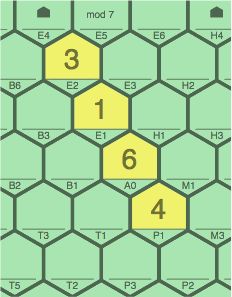
| 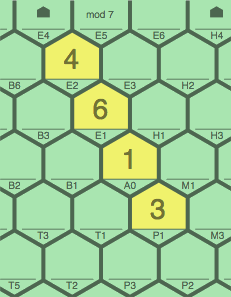
|
With three different slopes, it frequently happens that one sequence intersects another obliquely.
In the course of a game, players will often extend existing sequences instead of starting new ones; in figure 2E, cell P2 would contain 2 and cell E4 would contain 5. If a sequence is extended far enough, numbers will repeat:
… 3 ~ 5 ~ 0 ~ 2 ~ 4 ~ 6 ~ 1 ~ 3 ~ 5 ~ 0 ~ 2 ~ 4 …
A sequence has no particular maximum length, being extensible until it reaches the edge of the board or encounters a conflicting sequence.
The tilde notation, frequently employed in this report, uses the numbers on tiles as above, or uses cell addresses, or uses both, as convenient:
3 ~ 1 ~ 6 ~ 4
E2 ~ E1 ~ A0 ~ P1
3E2 ~ 1E1 ~ 6A0 ~ 4P1
§2-2. To count as a sequence, the tiles forming it must lie in an unbroken straight line. An additional rule is that whenever there is an unbroken straight line of tiles, they must form a legal (that is, modular-linear) sequence.
Continuing to use modulus 7, figure 2G contains two three-tile sequences, 4 ~ 6 ~ 1 and 1 ~ 3 ~ 5. However, 4 ~ 6 ~ 1 ~ 3 ~ 5 does not qualify as a five-tile sequence because it has a bend. This arrangement could nonetheless arise from legal moves by two players on successive turns.
| figure 2G |
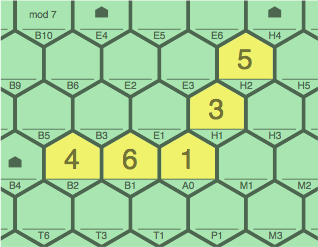
|
Figure 2H contains two three-tile sequences, 4-6-1 and 5-0-2, which could be connected into a seven-tile sequence by installing a 3 tile on cell M1.
| figure 2H |
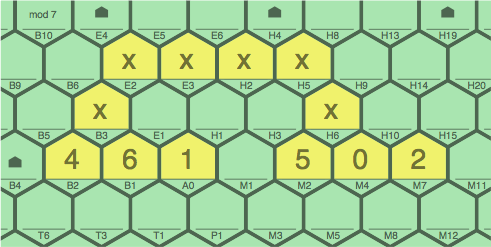
|
The tiles marked 'x' are necessary because, as play progresses, there can never be two disconnected networks of tiles. These 'x' tiles, which show one of many ways that the two sequences of interest might be connected, do contain genuine numbers in legal sequences; but in this example their exact values happen to be immaterial.
Figure 2I contains two three-tile sequences, 4 ~ 6 ~ 1 and 0 ~ 2 ~ 4, but they can never be connected by way of cell M1, because of a conflict between 4B2 ~ 6B1 ~ 1A0 ~ 3∗M1 and 5∗M1 ~ 0M2 ~ 2M4 ~ 4M7, where the infix asterisk indicates what tile could be installed if there were not a mismatch. M1 is now blocked, remaining vacant for the rest of the game.
| figure 2I |
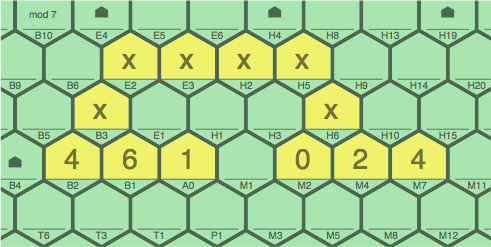
|
In figure 2J, cell M1 is again blocked for a similar reason: if M1 were to contain 3, M2 would have to contain 5, which it does not.
| figure 2J |
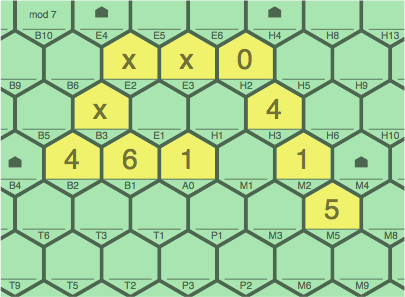
|
Some players might opt to obtain a supply of red tiles to be placed on blocked cells to conspicuously signify that they are ineligible for further use. A computerized version of MODLINSEQ could detect and mark the blocked cells automatically.
§2-3. The point value of a sequence is based on how many tiles it contains. It grows quadratically to greatly reward the player who can construct long sequences.
| table 2A | ||||
|---|---|---|---|---|
| length | points | length | points | |
| 1 | 0 | 7 | 15 | |
| 2 | 0 | 8 | 21 | |
| 3 | 1 | 9 | 28 | |
| 4 | 3 | 10 | 36 | |
| 5 | 6 | 11 | 45 | |
| 6 | 10 | 12 | 55 | |
| n | (n − 1) × (n − 2) ÷ 2 | |||
The reason that a 2-tile sequence counts zero is that no skill or luck is required in producing it: any two tiles, equal or unequal, form a legal sequence. Meanwhile, the sequence of 1 tile is of little more than theoretical interest.
§2-4. There is more to say about sequences, but the player who takes the time to understand them thoroughly has make great strides toward mastery of the game. Among other things, whence comes the name "MODLINSEQ"?
… 3 ~ 3 ~ 3 ~ 3 ~ 3 …
We use the MSA notation to describe a sequence. It consists of:
§2-5. When the modulus is a prime number, things are fairly simple. In the case of modulus 11 the following are all the possible sequences, and they fall into two obvious categories, as they will for any prime modulus:
| table 2B | ||||||
|---|---|---|---|---|---|---|
| M11-S1-A0 | … 0 ~ 1 ~ 2 ~ 3 ~ 4 ~ 5 ~ 6 ~ 7 ~ 8 ~ 9 ~ 10 … | period = 11 | M11-S0-A0 | … 0 … | period = 1 | |
| M11-S2-A0 | … 0 ~ 2 ~ 4 ~ 6 ~ 8 ~ 10 ~ 1 ~ 3 ~ 5 ~ 7 ~ 9 … | M11-S0-A1 | … 1 … | |||
| M11-S3-A0 | … 0 ~ 3 ~ 6 ~ 9 ~ 1 ~ 4 ~ 7 ~ 10 ~ 2 ~ 5 ~ 8 … | M11-S0-A2 | … 2 … | |||
| M11-S4-A0 | … 0 ~ 4 ~ 8 ~ 1 ~ 5 ~ 9 ~ 2 ~ 6 ~ 10 ~ 3 ~ 7 … | M11-S0-A3 | … 3 … | |||
| M11-S5-A0 | … 0 ~ 5 ~ 10 ~ 4 ~ 9 ~ 3 ~ 8 ~ 2 ~ 7 ~ 1 ~ 6 … | M11-S0-A4 | … 4 … | |||
| because M is prime, "-A0" could be omitted from the notation | M11-S0-A5 | … 5 … | ||||
| M11-S0-A6 | … 6 … | |||||
| M11-S0-A7 | … 7 … | |||||
| M11-S0-A8 | … 8 … | |||||
| M11-S0-A9 | … 9 … | |||||
| M11-S0-A10 | … 10 … | |||||
| because M is prime, "-S0" could be omitted from the notation | ||||||
For a non-prime number such as 12, there is greater variation in sequences because the modulus is a non-trivial multiple of some step sizes. When that happens, the anchor number becomes essential:
| table 2C | ||||||
|---|---|---|---|---|---|---|
| M12-S1-A0 | … 0 ~ 1 ~ 2 ~ 3 ~ 4 ~ 5 ~ 6 ~ 7 ~ 8 ~ 9 ~ 10 ~ 11 … | period = 12 | ||||
| M12-S5-A0 | … 0 ~ 5 ~ 10 ~ 3 ~ 8 ~ 1 ~ 6 ~ 11 ~ 4 ~ 9 ~ 2 ~ 7 … | |||||
| M12-S2-A0 | … 0 ~ 2 ~ 4 ~ 6 ~ 8 ~ 10 … | period = 6 | ||||
| M12-S2-A1 | … 1 ~ 3 ~ 5 ~ 7 ~ 9 ~ 11 … | |||||
| M12-S3-A0 | … 0 ~ 3 ~ 6 ~ 9 … | period = 4 | M12-S0-A0 | … 0 … | period = 1 | |
| M12-S3-A1 | … 1 ~ 4 ~ 7 ~ 10 … | M12-S0-A1 | … 1 … | |||
| M12-S3-A2 | … 2 ~ 5 ~ 8 ~ 11 … | M12-S0-A2 | … 2 … | |||
| M12-S4-A0 | … 0 ~ 4 ~ 8 … | period = 3 | M12-S0-A3 | … 3 … | ||
| M12-S4-A1 | … 1 ~ 5 ~ 9 … | M12-S0-A4 | … 4 … | |||
| M12-S4-A2 | … 2 ~ 6 ~ 10 … | M12-S0-A5 | … 5 … | |||
| M12-S4-A3 | … 3 ~ 7 ~ 11 … | M12-S0-A6 | … 6 … | |||
| M12-S6-A0 | … 0 ~ 6 … | period = 2 | M12-S0-A7 | … 7 … | ||
| M12-S6-A1 | … 1 ~ 7 … | M12-S0-A8 | … 8 … | |||
| M12-S6-A2 | … 2 ~ 8 … | M12-S0-A9 | … 9 … | |||
| M12-S6-A3 | … 3 ~ 9 … | M12-S0-A10 | … 10 … | |||
| M12-S6-A4 | … 4 ~ 10 … | M12-S0-A11 | … 11 … | |||
| M12-S6-A5 | … 5 ~ 11 … | |||||
There are additional listings for some primes (table 2D) and composites (table 2E). If m represents the modulus, and positive integer f is a factor of m, then there will be sequences whose period is m ÷ f.
Students of abstract algebra will observe properties of the cyclic groups.
§2-6. As forming modular-linear sequences is the whole point of the game, players will benefit from practice in calculating them:
| table 2F — exercises | |||
|---|---|---|---|
| determine the modulus | problems A | solutions A | each problem will have exactly one solution |
| extend both ends | problems B | solutions B | |
| fill 1-tile gap | problems C | solutions C | each problem may have multiple solutions, one, or none |
| fill 2-tile gap | problems D | solutions D | |
| fill 3-tile gap | problems E | solutions E | |
| fill 4-tile gap | problems F | solutions F | |
The quantity of solutions in the gap-filling case is predictable. Define these symbols:
For instance, consider 7 ~ x ~ y ~ 6 with modulus 10:
In the case where the modulus is a prime number, there will always be a unique solution.
§3. With equipment and sequences explained, here is how to play the game.
§3-1. Preliminaries.
Players need to negotiate:
After all is agreed on, players turn all the tiles face down on a table and scramble them, to form the stock. Then each takes the agreed-upon quantity of tiles from the stock to form their hand, looking at the tiles but keeping their numbers secret from opponents.
§3-2. General principles.
In a turn, each player transfers at least one tile from their hand to an empty cell on the board, but must never rearrange or remove any tiles that were already there when their turn began.
No cell may contain more than one tile.
At the end of each player's turn, it is necessary that every unbroken straight-line chain of tiles on the board be a legal sequence, that is, modular and linear as detailed in §2-4.
A player scores for the full length of every sequence they create, and for the full length of every sequence that they extend. For example, if a player combines four new tiles with three already on the board, forming a 7-tile sequence, it scores 15.
All the tiles that a player adds in one turn must lie in one unbroken straight line — this is called the primary sequence. This sequence may incorporate tiles that were already on the board from the previous turns of any players.
Often tiles of the primary sequence will combine with other tiles already on the board, incidentally forming or extending other unbroken straight lines of tiles oblique to the primary:
If a player in their turn adds only one tile and it lies in two or three sequences, the player may (if a decision need be made) choose any one of the sequences to declare primary with the others being secondary.
A sequence cannot "wrap around" from one edge of the board to the opposite edge.
§3-3. The action.
The first player installs a sequence on the board that must pass through the center cell, A0. It may be of positive, negative, or zero slope; and the player can choose which tile of the sequence will reside on A0.
After that, each player in turn either extends a sequence that already exists, or creates a new sequence. At least one added tile must abut at least one tile that was already on the board.
At the end of each turn, a player draws enough tiles from the stock (if any remain) to restore their hand to its full size. Once the stock becomes empty, play continues but players' hands will shrink.
The game ends when every player has frozen:
Whoever ends up with the most points is the winner. Ties are possible, but unlikely.
Page 2 (§4-5-6) — examples